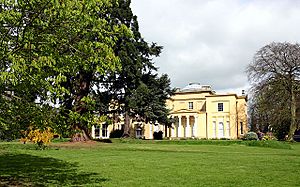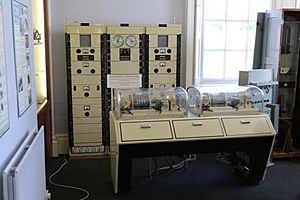British Horological Institute facts for kids
The British Horological Institute (BHI) is a special group for people who love and work with clocks and watches in the United Kingdom. It was started by clockmakers in 1858. Today, the BHI is based at Upton Hall in Nottinghamshire. This place also has a museum about the history of clocks.
Contents
The BHI's Story: How It Started
The British Horological Institute began in 1858. A small group of clockmakers, including Edward Daniel Johnson, created it. They wanted to bring together all the clock and watch businesses in Britain. At that time, many clocks and watches were coming from other countries.
The BHI quickly became successful. Within a year, they opened their own museum and library. They also started evening classes to teach people how to make and fix clocks and watches.
The BHI publishes a magazine called the Horological Journal. It has been printed every month since September 1858. This makes it the oldest technical magazine in the world that has been published without stopping.
Upton Hall: Home of Timekeeping
The BHI's main home is at Upton Hall in Nottinghamshire, England. A big part of what they do there is education. They offer special exams for people who want to become expert clock and watch repairers.
The BHI also keeps a list of members who are very skilled. These members are trusted to fix clocks and watches. They follow a strict set of rules to do their work well.
Upton Hall is also where you can find the Museum of Timekeeping. This museum holds the original BHI Museum and Library.
Joining the BHI: Become a Member
The British Horological Institute has different ways for people to join.
- Associate Membership
Anyone who is interested in clocks and watches can become an Associate Member.
- Accredited: Member of the BHI (MBHI)
To become an accredited Member, you need to pass the BHI's Level 4 exams. People who reach this level can use "MBHI" after their name.
Accredited: Fellow of the BHI (FBHI) The next step up is Fellowship. You can become a Fellow by passing the BHI's Level 5 exams. You can also become a Fellow if you have done amazing things in your career. People at this level can use "FBHI" after their name.
Businesses can also join the BHI through corporate membership or business partnerships.
The Museum of Timekeeping
The Museum of Timekeeping is located inside Upton Hall. It is part of the British Horological Institute.
This museum is a charity that started in 1994. Its job is to protect the collection of clocks, watches, and books. These items were gathered by BHI members since 1858.
The museum has many clocks, watches, and tools used to make them. You can visit the museum during certain times of the year. They also have special events and you can book group visits.
The Museum of Timekeeping Library is a very special library. It focuses mainly on horology, which is the study of time and timekeeping. Researchers can visit the library by making an appointment. It has many old and rare documents, letters, and books. These often tell stories from the 1700s and early 1800s, when British clockmaking was at its best.
One important book in the library is THROUGH THE GOLDEN AGE – Charles Gretton – Watch and Clockmaking. This large book, published in 2016, is about the famous clockmaker Charles Gretton (1647–1731).
BHI Gold Medal: Honoring Greatness
The BHI gives a special gold medal to people who have made amazing contributions to the world of timekeeping. Here are some of the people who have received it:
- 1928 Frank Watson Dyson - An astronomer who helped start the Greenwich pips. These are the short beeps you hear before the news.
- 1930 Charles Édouard Guillaume - He created special metals called Invar and Elinvar. These metals do not change size much with temperature.
- 1931 William Hamilton Shortt (1881-1971) - A famous clock expert who invented the very accurate Shortt–Synchronome clock.
- 1946 Frank Hope-Jones (1867–1950) - He developed ways to keep time using electricity, like the Synchronome system.
- 1947 Rupert Gould - He carefully fixed John Harrison's famous chronometer clocks.
- 1947 Warren Alvin Marrison - He helped create the quartz crystal clock, which is very precise.
- 1948 Harold Spencer Jones - Another Astronomer Royal, a top astronomer for the King or Queen.
- 1957 John Harwood - He invented the self-winding wristwatch. This watch winds itself as you move.
- 1981 George Daniels - He developed the co-axial escapement. This is a special part inside watches that helps them keep time better. It is now used by the Omega watch company.
See also
 In Spanish: Instituto Horológico Británico para niños
In Spanish: Instituto Horológico Británico para niños




